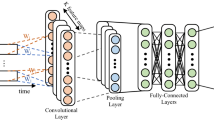Abstract
Speech recognition has become an essential component to communicate with the latest gadgets and machines in ease through speech. Phoneme classification model for phonemes in Tamil continuous speech is built here by exploring the power of deep belief network (DBN), a powerful neural network architecture that is capable of learning complex problems. But building an efficient DBN highly relies on several parameters like number of layers, number of neurons, connection weights and bias. The effect of increasing the number of layers in DBN for phoneme recognition has been studied in our previous experiments. In addition, a methodology which employed particle swarm optimization (PSO) or its variants second generation PSO (SGPSO) and new method PSO (NMPSO) for optimizing the connection weights and bias of the DBN for phoneme classification were studied in our earlier work. Pre-training DBN with PSO faced the problem of particle stagnation and took longer time to converge, whereas DBN with SGPSO, NMPSO converges faster but still suffers from particle stagnation which prevents it from reaching an optimal solution. Here we try to minimize stagnation of particles in the population in addition to faster convergence by proposing a new improved PSO, named Temperature controlled TPSO to optimize the initial connection weights and bias parameters that controls the DBN efficiency. TPSO seems to converge faster with better optimizing the DBN connection weights and bias parameters when compared to the existing ones with reduced stagnation of population. The TPSO–DBN is designed and applied on a phoneme classification problem for Tamil continuous speech and found to classify phonemes comparatively better with a classification accuracy of 89.2%.














Similar content being viewed by others
References
Chen, M. (2008). Second generation particle swarm optimization. In IEEE World Congress on computational intelligence evolutionary computation (pp. 90–96). CEC 2008.
Ciregan, D., Meier, U., & Schmidhuber, J. (2012). Multi-column deep neural networks for image classification. In IEEE conference on computer vision and pattern recognition (CVPR), 2012, IEEE, pp. 3642–3649.
Da, Y., & Xiurun, G. (2005). An improved pso-based ann with simulated annealing technique. Neurocomputing, 63, 527–533.
Eberhart, R., & Kennedy, R. J. (1995). Particle swarm optimization. In Proceedings of IEEE international conference on neural networks IV, Vol. 1000.
Garro, B.A., Sossa, H., & Vazquez, R.A. (2009). Design of artificial neural networks using a modified particle swarm optimization algorithm. In International Joint Conference on Neural Networks, 2009. IJCNN 2009, IEEE, pp. 938–945.
Gordan, B., Armaghani, D. J., Hajihassani, M., & Monjezi, M. (2016). Prediction of seismic slope stability through combination of particle swarm optimization and neural network. Engineering with Computers, 32(1), 85–97.
Hand, D. J., & Till, R. J. (2001). A simple generalisation of the area under the roc curve for multiple class classification problems. Machine Learning, 45(2), 171–186.
Hinton, G. E. (2006). Training products of experts by minimizing contrastive divergence. Training, 14(8), 1771–1800.
Hinton, G.E., Srivastava, N., Krizhevsky, A., Sutskever, I., & Salakhutdinov, R.R. (2012). Improving neural networks by preventing co-adaptation of feature detectors. arXiv preprint arXiv:12070580.
Laxmi Sree, B. R., & Suguna, M. (2016). Aayudha: A tool for automatic segmentation and labelling of continuous tamil speech. International Journal of Computer Applications, 143(1), 31–35.
Laxmi Sree, B. R., & Vijaya, M. S. (In Pressa) Building acoustic model for phoneme recognition using PSO-DBN. International Journal of Business Intelligence and Data Mining. https://doi.org/10.1504/IJBIDM.2018.10010711.
Laxmi Sree, B. R., & Vijaya, M. S. (2017). Deep belief networks for phoneme recognition in continuous Tamil speech–an analysis. Traitement du signal, 34(3–4), 137–151. https://doi.org/10.3166/ts.34.137-151.
Løvbjerg, M., Rasmussen, T.K., & Krink, T. (2001). Hybrid particle swarm optimiser with breeding and subpopulations. In Proceedings of the 3rd annual conference on genetic and evolutionary computation, Morgan Kaufmann Publishers Inc., pp. 469–476.
Laxmi Sree, B. R., & Vijaya, M. S. (2016). Graph cut based segmentation method for Tamil continuous speech. In S. Subramanian, R. Nadarajan, S. Rao, & S. Sheen (Eds.), Digital connectivity—Social impact. Communications in computer and information science (Vol. 679). Singapore: Springer.
Srinivasan, A., & Srinivasan, A. (1999). Note on the location of optimal classifiers in n-dimensional roc space. Tech. rep.
Yu, J., Xi, L., & Wang, S. (2007). An improved particle swarm optimization for evolving feedforward artificial neural networks. Neural Processing Letters, 26(3), 217–231.
Yu, J., Wang, S., & Xi, L. (2008). Evolving artificial neural networks using an improved pso and dpso. Neurocomputing, 71(4), 1054–1060.
Zhang, R., & Tao, J. (2017). Data-driven modeling using improved multi-objective optimization based neural network for coke furnace system. IEEE Transactions on Industrial Electronics, 64(4), 3147–3155.
Author information
Authors and Affiliations
Corresponding author
Appendix
Rights and permissions
About this article
Cite this article
Laxmi Sree, B.R., Vijaya, M.S. Temperature controlled PSO on optimizing the DBN parameters for phoneme classification. Int J Speech Technol 22, 143–156 (2019). https://doi.org/10.1007/s10772-018-09586-2
Received:
Accepted:
Published:
Issue Date:
DOI: https://doi.org/10.1007/s10772-018-09586-2




